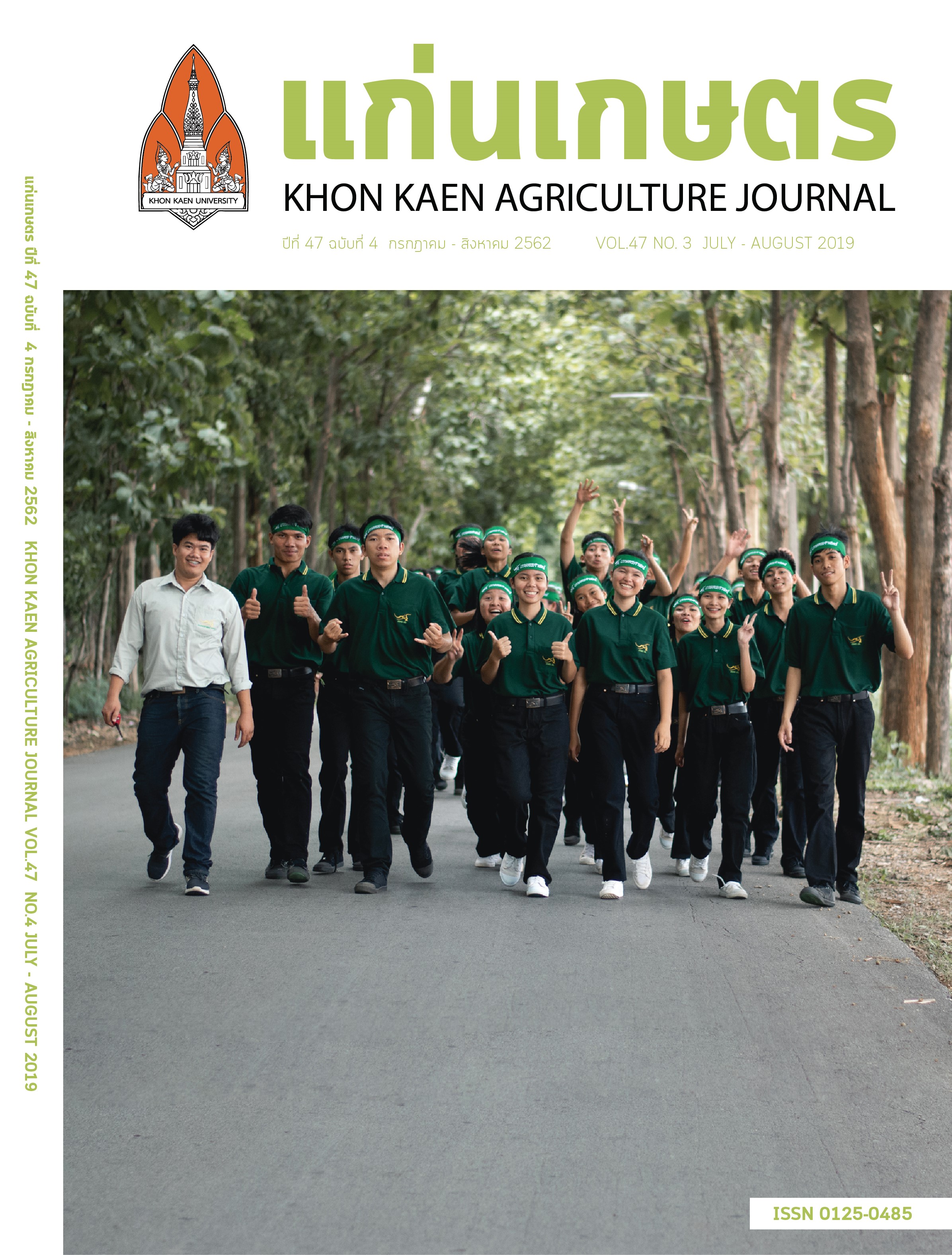ศักยภาพการให้ผลผลิตของพันธุ์ข้าวโพดไร่ลูกผสมภายใต้วิธีการไถพรวนปกติและการลดการไถพรวนในสภาพหลังนา จังหวัดเพชรบูรณ์
Main Article Content
บทคัดย่อ
การปลูกข้าวโพดไร่ในสภาพดินนา จำเป็นต้องมีแนวทางการจัดการเทคโนโลยีที่เหมาะสม เพื่อเพิ่มศักยภาพในการผลิตข้าวโพด ตอบสนองต่อความต้องการของอุตสาหกรรมอาหารสัตว์ จึงศึกษาศักยภาพการให้ผลผลิตของพันธุ์ข้าวโพดไร่ลูกผสมภายใต้วิธีการไถพรวนปกติและการลดการไถพรวนในสภาพหลังนา ทำการทดลองในแปลงเกษตรกร อำเภอหล่มสัก จังหวัดเพชรบูรณ์ วางแผนการทดลองแบบ split plot in RCBD จำนวน 4 ซ้ำ ปัจจัยหลัก คือ วิธีการไถพรวน 2 วิธี ได้แก่ การไถพรวนปกติ (ไถผาลหก 1 ครั้ง และพรวนด้วย rotary 4 ครั้ง) และการลดการไถพรวน (ไถผาลหก 1 ครั้ง และพรวนด้วย rotary 2 ครั้ง) ปัจจัยรอง คือ ข้าวโพดไร่ลูกผสม 16 พันธุ์ ได้แก่ KSX5720, KSX5810, KSX5813, KSX5908, KSX5930, KSX5931, NSX052014, NSX042022, PAC339, CP639, S7328, DK6818, P4546, KWS8933, NS3, SW4452 (พันธุ์เปรียบเทียบ) ผลการศึกษาพบว่า วิธีการไถพรวนทำให้ข้าวโพดมีความสูงต้นและความสูงฝัก วันสลัดละอองเกสร 50% และวันออกไหม 50% ต้นล้ม เปอร์เซ็นต์กะเทาะ ความชื้นเมล็ด น้ำหนัก 100 เมล็ด และผลผลิตเมล็ด/ไร่ไม่แตกต่างกันทางสถิติ แต่แตกต่างกันทางสถิติระหว่างพันธุ์ข้าวโพด วิธีการไถพรวนกับพันธุ์ข้าวโพดไม่มีปฏิสัมพันธ์กัน เมื่อวิเคราะห์ความแปรปรวนรวมภายใต้วิธีการไถพรวนปกติและการลดการไถพรวนในสภาพหลังนา พบว่า ข้าวโพดไร่ลูกผสมทุกพันธุ์มีศักยภาพในการให้ผลผลิตสูงกว่าพันธุ์ SW4452 ตั้งแต่ 2-26% และจากการวิเคราะห์ต้นทุนและผลตอบแทนการผลิต พบว่า การลดการไถพรวนมีต้นทุนต่ำกว่าการไถพรวนปกติ ทำให้มีผลตอบแทนสูงกว่า ดังนั้นการลดการไถพรวน สามารถใช้เป็นวิธีเตรียมดินปลูกข้าวโพดในสภาพดินนาได้ เนื่องจากการลดการไถพรวนให้ผลผลิตและผลตอบแทนสูงกว่าเมื่อเทียบกับการไถพรวนปกติ
Article Details
เอกสารอ้างอิง
พิพัฒน์ วีระถาวร. 2529. ผลของระบบการเตรียมดินและอัตราของปุ๋ ยผสมที่มีต่อผลผลิตข้าวโพด. วิทยานิพนธ์ปริญญาวิทยาศาสตรมหาบัณฑิต มหาวิทยาลัยเกษตรศาสตร์, กรุงเทพฯ.
สุดารัตน์ สกุลคู. 2527. อิทธิพลของระบบการไถพรวนและวิธีการกำจัดวัชพืชที่มีต่อผลผลิตและลักษณะทางการเกษตรบางประการของข้าวโพด. วิทยานิพนธ์ปริญญาวิทยาศาสตรมหาบัณฑิต มหาวิทยาลัยเกษตรศาสตร์, กรุงเทพฯ.
สำนักงานปลัดกระทรวงมหาดไทย. 2560. ข้อมูลด้านนโยบายด้านการเกษตร ปี 2560. กลุ่มกิจการพิเศษ สำนักนโยบายและแผน สำนักงานปลัดกระทรวงมหาดไทย, กรุงเทพฯ.
สำานักงานเศรษฐกิจการเกษตร. 2560. สถิติการเกษตรของประเทศไทย ปี 2560 แหล่งข้อมูล: http://www.oae.go.th/assets/portals/1/files/yearbook60.pdf. ค้นเมื่อ 29 ตุลาคม 2561.
Boonpradub, S., M. Chatairi, and N. Senanarong. 1998. Maize cultivation in paddy field research in Thailand. p. 399-406. In: S.K. Vasal et al (eds.). Proceedings of The 7th Asian Regional Maize Workshop. PCARRD, Los Banos, Philippines.
Canatoy, R.C. 2018. Growth and yield response of sweet corn (Zea mays l. var. Saccharata) as affected by tillage operations and fertilizer applications. Int. J. Educ. Res. 6:265-276.
Hofmann, N. 2015. Conventional tillage: How conventional is it?. Available: http:// www.statcan.gc.ca/pub/16-002-x/2008003/article/10688-eng.htm. Accessed May 7, 2016.
Mohammed, H., T. Shiferaw, and S.T. Tadesse. 2015. Nitrogen and phosphorus fertilizers and tillage effects on growth and yield of maize (Zea mays L.) at Dugda district in the Central Rift Valley of Ethiopia. Asian J. Crop Sci. 7(4):277-285.
Mu, X.Y., Y.L. Zhao, K. Liu, B.Y. Ji, H.B. Guo, Z.W. Xue, and C.H. Li. 2016. Responses of soil properties, root growth and crop yield to tillage and crop residue management in a wheat-maize cropping system on the North China Plain. Eur. J. Agron. 82:125-133.
Na Nagara, T., C. Tongyai, D. Ngovathana, and S. Nualla-ong. 1985. The no-tillage system for corn (Zea mays L.). p. 20. In: The sixteenth Thai National Corn and Sorghum Reporting Session. Pearl Hotel, Phuket.
Office of Agricultural Economics. 2018. Maize: Maize Price. Available: http://oleweb.oae.go.th/download/price/monthlyprice/maize.pdf. Accessed May 17, 2018.Sessiz, A., A. Alp, and S. Gursoy. 2010. Conservation and conventional tillage methods on selected soil physical properties and corn (Zea mays L.) yield and quality under cropping system in Turkey. Bulg. J. Agric. Sci.16:597-608.
Singh G., J.S. Kang, and H. Singh. 2017. Productivity of kharif maize (Zea mays L.) as influenced by sub soiling and planting methods. Int. J. Curr. Microbiol. App. Sci. 6:513-521.
Thiagalingam, K., N. P. Dalggliesh, N. S., Gould, R. L., Mccown, A. L.Cogle, and A. L. Chapman. 1996. Comparison of no-tillage and conventional tillage in the development of sustainable farming system in the semi-arid tropics. Aus. J. Exp. Agric. 36:995-1002.
Upadhyay, S.R., K.B. Basnet, S. Marahattha, and T.B. Karki. 2017. Integrated weed management under tillage methods on summer season maize in sub humid condition of Inner Terai, Nepal. Int. J. Res. Sci. Eng. 3 :245-252.
Wang, X.B., B.Y. Zhou, X.F. Sun, Y. Yue, W. Ma, and M. Zhao. 2015. Soil tillage management affects maize grain yield by regulating spatial distribution coordination of roots, soil moisture and nitrogen status. PLOS ONE 10:e0129231.
Yalcin, H., and E. Cakir. 2006. Tillage effects and energy efficiencies of subsoiling and direct seeding in light soil on yield of second crop corn for silage in Western Turkey. Soil Till. Res. 90:250- 255.
Zhai, L., P. Xu, Z. Zhang, S. Li, R. Xie, and L. Zhai. 2017. Effect of deep vertical rotary tillage on dry matter accumulation and grain yield of summer maize in the Huang-Huai-Hai Plain of China. Soil Till. Res. 170:167-174.


